Disclaimer
In this guide, I will use Fedora 41 Cloud Edition as the base operating system. Some steps may vary depending on the distribution you are using.
This guide is similar to the Vanilla Kubernetes Setup with Tailscale guide. It differs from the other guide only in a few steps.
Introduction
- K0s is a lightweight, easy-to-use Kubernetes distribution that is designed for developers and small teams. It is a single binary that can be installed on any Linux machine and provides a simple way to set up a Kubernetes cluster.
- Tailscale is a virtual private network (VPN) service that facilitates secure access to a network from any location worldwide. The configuration process is straightforward and the software is compatible with a range of operating systems, including Windows, macOS, Linux, iOS and Android.
- This guide will demonstrate the process of establishing a basic K0s Kubernetes cluster using the Tailscale VPN infrastructure.
Prerequisites
- A Tailscale account
- Two or more machines with a minimum of a 2-core CPU and 4 GB of RAM, running a Linux operating system.
I will use the following machines:
- Master Node:
- Hostname: m1.srv.mtaha.dev
CPU: Intel(R) Celeron(R) N3450 (4) @ 2.20 GHz (x86_64)
RAM: 8 GB
OS: Fedora 41 Cloud Edition
Location: Homelab
Machine: Zimaboard 832- Worker Node 1:
- Hostname: w1.srv.mtaha.dev
CPU: Intel Xeon (Skylake, IBRS, no TSX) (4) @ 2.10 GHz (x86_64) [Upgraded today]
RAM: 8 GB [Upgraded today]
OS: Fedora 41 Cloud Edition
Location: Hetzner Cloud
Machine: CX32 [Upgraded today]- Worker Node 2:
- Hostname: w2.srv.mtaha.dev
CPU: ARM Cortex-A76 (4) @ 2.40 GHz (aarch64)
RAM: 8 GB
OS: Fedora 41 Cloud Edition
Location: Homelab
Machine: Raspberry Pi 5 - 8 GB
Step 1: Install Tailscale
-
Install Tailscale on all machines where Kubernetes will be installed. Use the following script to automate the Tailscale installation process on machines:
curl -fsSL https://tailscale.com/install.sh | sh -
Once Tailscale has been installed, use the following command to authenticate it:
sudo tailscale up -
The command will provide you with a URL. Open the URL in your browser and authenticate your machine.
Step 2: Set up Tailscale ACL
-
The next step is to configure the Tailscale ACL (access control list) to allow communication between machines in your Kubernetes cluster. You can edit the ACL list from this link. I recommend that you use the following ACL list:
{ "tagOwners": { "tag:personal": ["autogroup:admin"], "tag:servers": ["autogroup:admin"], "tag:k8s-operator": ["autogroup:admin"], "tag:k8s-node": ["tag:k8s-operator"], "tag:k8s-pods": ["tag:k8s-operator"], }, "acls": [ { "action": "accept", "src": ["tag:personal"], "dst": ["*:*"], }, { "action": "accept", "src": [ "autogroup:admin", "tag:servers", "tag:k8s-node", "tag:k8s-pods", "tag:k8s-operator", "10.0.0.0/8", "172.16.0.0/16", ], "dst": [ "tag:servers:*", "tag:k8s-node:*", "tag:k8s-pods:*", "tag:k8s-operator:*", "10.0.0.0/8:*", "172.16.0.0/16:*", ], }, ], "ssh": [ { "action": "accept", "src": ["autogroup:admin", "tag:personal"], "dst": ["tag:servers"], "users": ["autogroup:nonroot", "root", "fedora"], }, ], } -
After configuring the ACL list, you can apply the ACL tags to the machines in the main Tailscale dashboard.
Select the machine > click on the ellipsis and select Edit ACL Tags > add the tags ‘servers’ and ‘k8s-node’ to the Kubernetes nodes.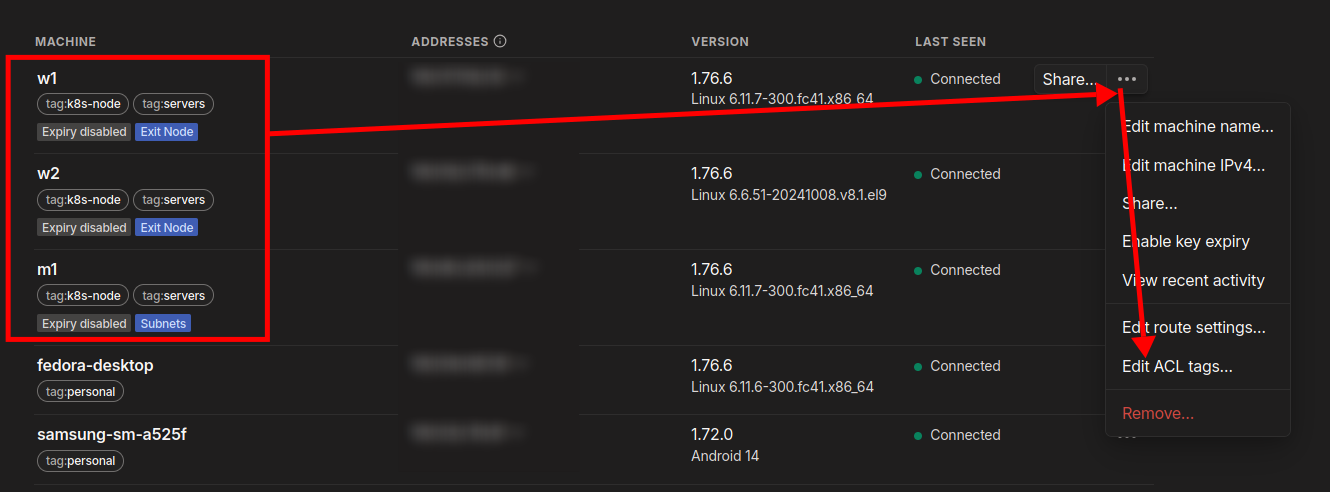
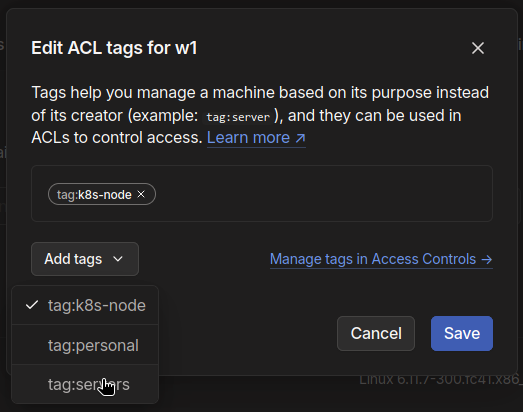
Step 3: Set up Hostname and Hosts File
-
The next step is to set up the hostname and hosts file on all the machines. This can be done by editing the
/etc/hostnameand/etc/hostsfiles on each machine. In newer distributions, thehostnamectlcommand can be used to set the hostname.sudo hostnamectl set-hostname <hostname>
-
Then edit the
/etc/hostsfile. Add the following lines for the per machine:127.0.0.1 <hostname> ::1 <hostname>Note
Replace
<hostname>with the hostname of the machine.
Step 4: Set up FirewallD rules
-
The next step is to configure the FirewallD rules on all the machines. To do this, run the following commands:
#~ flush all rules sudo iptables -F #~ add tailscale and kubernetes cni interfaces sudo firewall-cmd --zone=trusted --permanent --add-interface={tailscale0,cni0,vxlan.calico,flannel.1,cali+} #~ add ports for kubernetes sudo firewall-cmd --zone=public --permanent --add-service={dns,http,https,mdns,llmnr} #~ enable masquerade and forwarding sudo firewall-cmd --permanent --add-forward sudo firewall-cmd --permanent --add-masquerade #~ reload firewall sudo firewall-cmd --reload
Step 5: Enable CGroup and Disable Swap
-
The next step is to enable CGroup and disable swap on all the machines. CGroup is a Linux kernel feature that provides a way to limit, account for, and isolate the resource usage of a collection of processes. To enable CGroup and disable swap, look at the following steps:
-
If you are using swap (not zram), you need to disable it by running the following commands:
sudo swapoff -a sudo vim /etc/fstab #~ comment the swap line-
Example:

-
-
For GRUB users:
-
Open the
/etc/default/grubfile and change the following line:GRUB_CMDLINE_LINUX="cgroup_enable=memory systemd.zram=0"
-
-
For systemdboot users:
-
Open the
/etc/kernel/cmdlinefile and add the following lines:cgroup_enable=memory systemd.zram=0
-
-
For Raspberry Pi users:
-
Open the
/boot/cmdline.txtfile and add the following lines:cgroup_enable=memory systemd.zram=0
-


Step 6: Enable IP Forwarding and Load Required Modules
-
The next step is to enable IP forwarding on all the machines. To do this, follow the steps below:
-
Open the
/etc/sysctl.d/kubernetes.conffile and add the following lines:net.bridge.bridge-nf-call-ip6tables = 1 net.bridge.bridge-nf-call-iptables = 1 net.ipv6.conf.all.forwarding = 1 net.ipv4.conf.all.src_valid_mark = 1 net.ipv4.ip_forward = 1
-
Then run the following command to apply the changes:
sudo sysctl --system -
After that, we need to load the some required kernel modules. Create a file named
/etc/modules-load.d/kubernetes.confand add the following lines:br_netfilter overlay
Step 7: Update System Packages
-
The next step is to update the system packages on all the machines. To complete this step, run the following commands:
# For Ubuntu/Debian sudo apt update && sudo apt upgrade -y # For CentOS/RHEL sudo dnf --refresh update -y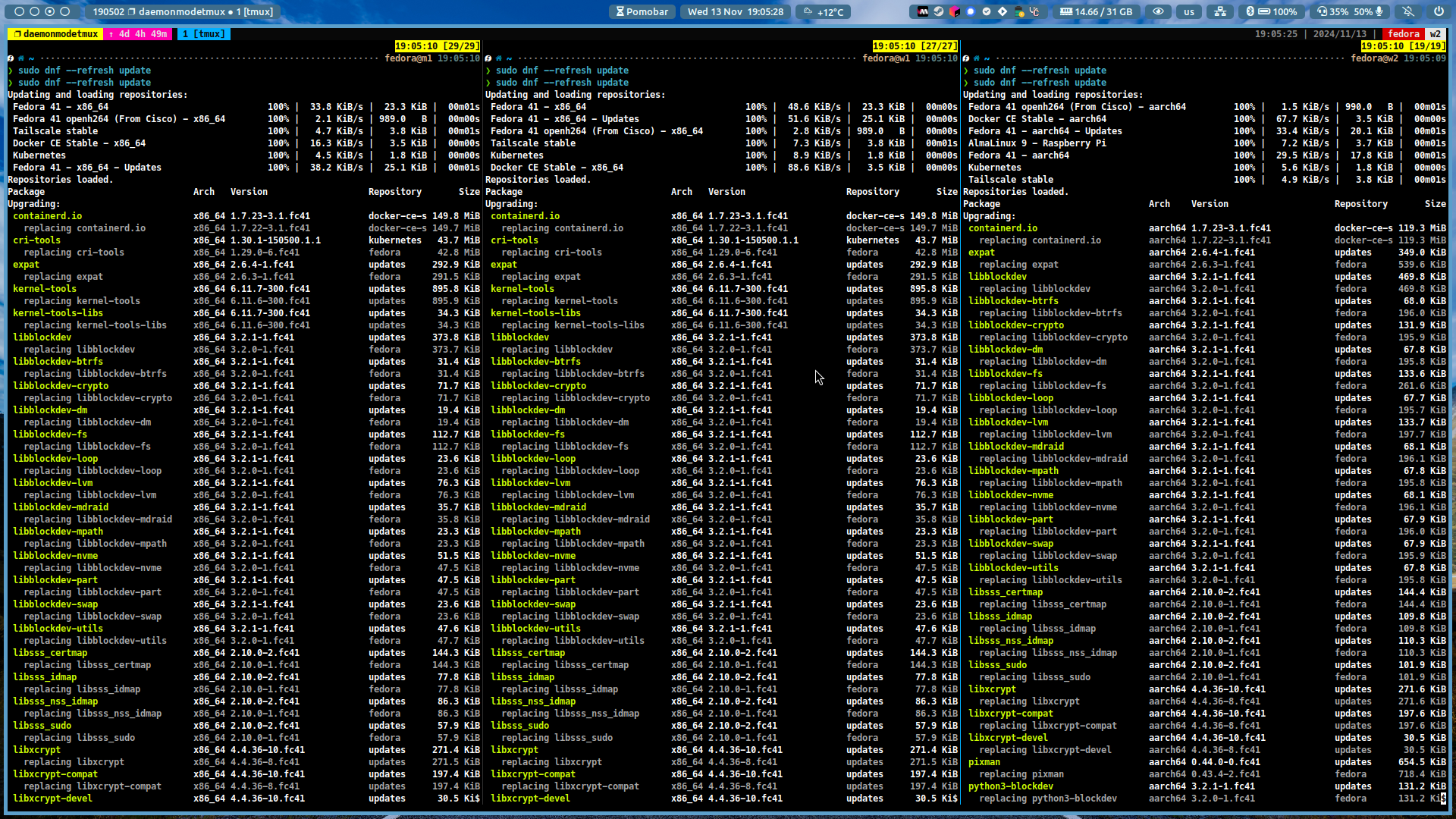
Step 8: Regenerate Initramfs and Apply Bootloader Configuration
-
In the next step, you need to regenerate the initramfs and apply the bootloader configuration to all the machines. You can do this by running the following commands:
-
For GRUB users:
# For Ubuntu/Debian sudo update-initramfs -u sudo update-grub # For CentOS/RHEL sudo dracut -fv sudo grub2-mkconfig -o /boot/grub2/grub.cfg -
For systemdboot users:
# For Ubuntu/Debian sudo update-initramfs -u sudo systemctl restart systemd-boot-update # For CentOS/RHEL sudo dracut -fv sudo dnf reinstall -y kernel-core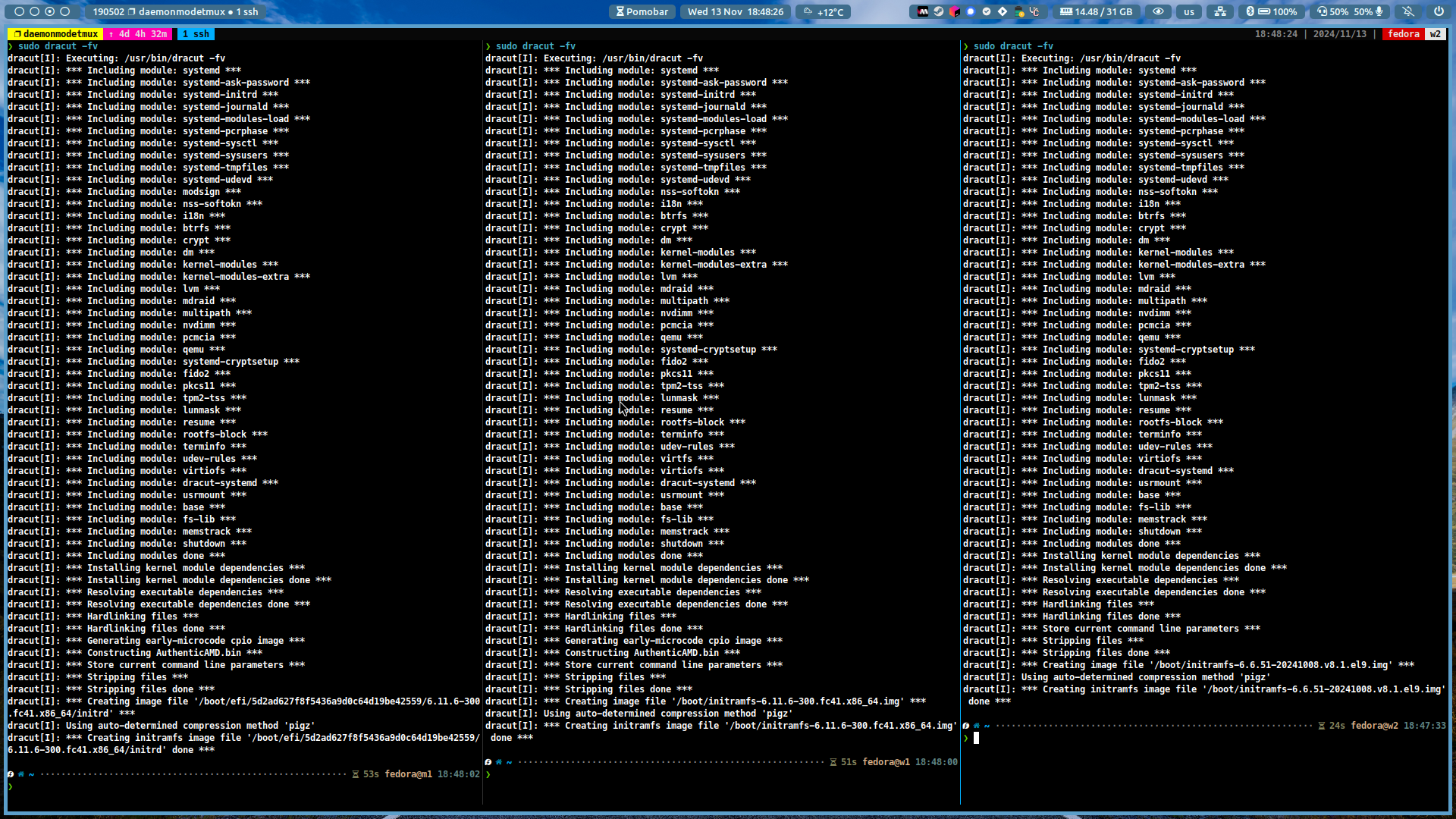

Step 9: Verify the Changes
-
You can verify the changes by running the following commands:
# Check the swap/zram status (if output is empty, it means swap/zram is disabled) swapon zramctl # Check the CGroup status cat /proc/cgroups

Optional Step: Install K9s CLI
- K9s is a powerful CLI tool that provides a terminal-based interface for managing Kubernetes clusters. You can install K9s by following the steps in the official K9s documentation.
Step 10: Set up K0s and K0sctl
-
In this step, you will set up the K0s binaries on your computer (not the servers). You can install k0s by running the following commands:
curl -sSLf https://get.k0s.sh | sudo sh -
Once the installation is complete, you can install
k0sctlby running the following commands:#~ find your k0sctl version (distro + architecture) curl -sSLf https://api.github.com/repos/k0sproject/k0sctl/releases/latest | jq -r '.assets[].browser_download_url' #~ download k0sctl sudo wget <URL> -O /usr/local/bin/k0sctl sudo chmod +x /usr/local/bin/k0sctl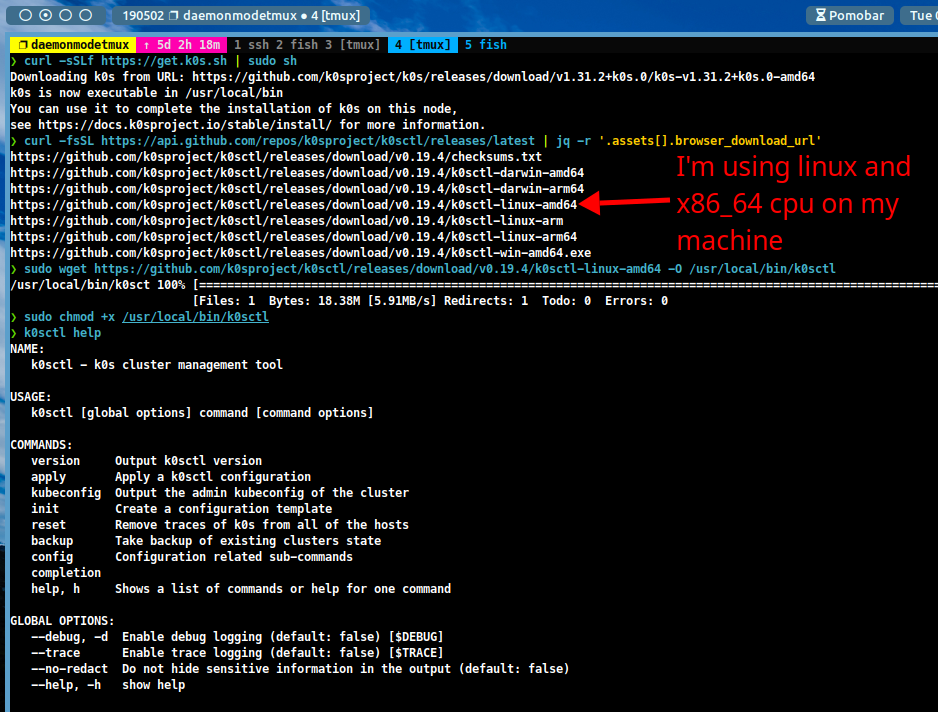
Step 11: Set up K0SCTL Init File
-
In the next step, you can create a K0sctl init file to define the cluster configuration. You can create the file by running the following command:
vim k0sctl.yaml -
Then add the following content to the file:
apiVersion: k0sctl.k0sproject.io/v1beta1 kind: Cluster metadata: name: k0s-cluster spec: hosts: - ssh: address: 1.2.3.4 # Write the IP address of the master node here (tailscale ip --4 m1) user: root port: 22 keyPath: null role: controller+worker privateInterface: tailscale0 installFlags: - '--kubelet-extra-args=\"--node-ip=1.2.3.4\"' # Write the IP address of the master node here (tailscale ip --4 m1) - ssh: address: 2.3.4.5 # Write the IP address of the worker node 1 here (tailscale ip --4 w1) user: root port: 22 keyPath: null role: worker privateInterface: tailscale0 installFlags: - '--kubelet-extra-args=\"--node-ip=2.3.4.5\"' # Write the IP address of the worker node 1 here (tailscale ip --4 w1) - ssh: address: 3.4.5.6 # Write the IP address of the worker node 2 here (tailscale ip --4 w2) user: root port: 22 keyPath: null role: worker privateInterface: tailscale0 installFlags: - '--kubelet-extra-args=\"--node-ip=3.4.5.6\"' # Write the IP address of the worker node 2 here (tailscale ip --4 w2) k0s: version: 1.33.2+k0s.0 config: apiVersion: k0s.k0sproject.io/v1beta1 kind: Cluster metadata: name: k0s spec: api: address: 1.2.3.4 # Write the IP address of the master node here (tailscale ip --4 m1) k0sApiPort: 9443 port: 6443 installConfig: users: etcdUser: etcd kineUser: kube-apiserver konnectivityUser: konnectivity-server kubeAPIserverUser: kube-apiserver kubeSchedulerUser: kube-scheduler konnectivity: adminPort: 8133 agentPort: 8132 network: kubeProxy: disabled: false mode: iptables kuberouter: autoMTU: true mtu: 0 peerRouterASNs: "" peerRouterIPs: "" podCIDR: 172.16.0.0/16 provider: calico calico: mode: vxlan envVars: FELIX_IPTABLESMARKMASK: "0xff00ff00" IP_AUTODETECTION_METHOD: "interface=tailscale0" serviceCIDR: 10.96.0.0/12 podSecurityPolicy: defaultPolicy: 00-k0s-privileged storage: type: etcd telemetry: enabled: falseNote
If you are using systemd-resolved, you need append to the
kubelet-extra-argsthe following line:--resolv-conf=/run/systemd/resolve/resolv.conf.
For example:--kubelet-extra-args=\"--node-ip=<IP_ADDRESS> --resolv-conf=/run/systemd/resolve/resolv.conf\"
Step 12: Initialize K0s Cluster
-
In the next step, you can initialise the K0s cluster by running the following command:
k0sctl apply --config k0sctl.yaml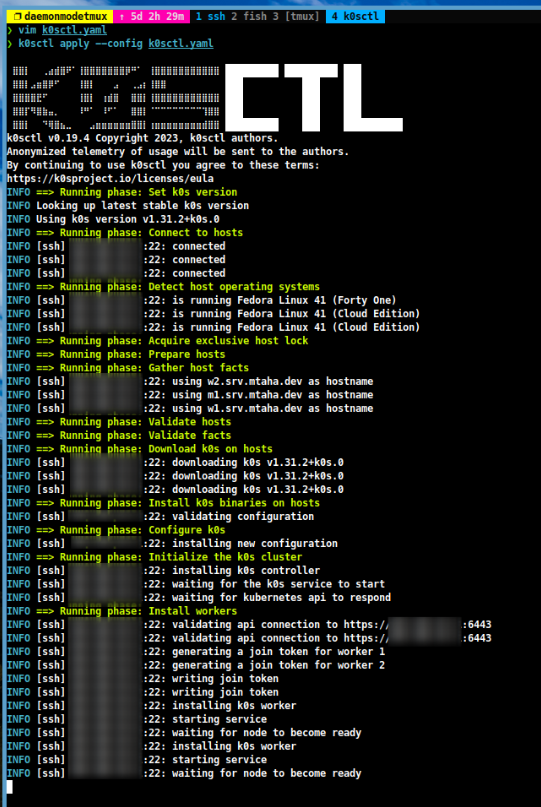
-
After the initialisation process is complete, run the following commands to set up the Kubernetes configuration file:
mkdir -p $HOME/.kube k0sctl kubeconfig --config k0sctl.yaml > $HOME/.kube/config sudo chmod 0700 $HOME/.kube/config
Step 13: Install Helm Package Manager in Master Node
-
In the next step, install the HELM package manager in the master node. HELM is a package manager for Kubernetes that allows you to deploy and manage applications on your Kubernetes cluster. You can install HELM by running the following commands:
curl https://raw.githubusercontent.com/helm/helm/main/scripts/get-helm-3 | bash
Step 14: Install MetalLB Load Balancer
-
The next step is to install the MetalLB load balancer on the Kubernetes cluster. MetalLB is a load balancer that provides network load balancing for Kubernetes clusters. You can install MetalLB by running the following steps:
-
Create a file with the name `metallb.yaml’ and add the following content:
apiVersion: metallb.io/v1beta1 kind: IPAddressPool metadata: name: default namespace: metallb-system spec: addresses: - 172.16.20.0/24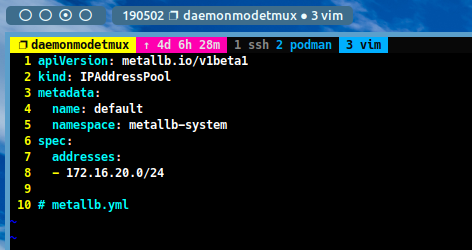
-
Install MetalLB by Helm with the following command:
helm repo add metallb https://metallb.github.io/metallb helm install metallb metallb/metallb --namespace metallb-system --create-namespace until $(kubectl get pods -n metallb-system --no-headers | awk '{print $3}' | uniq | grep -q 'Running'); do echo "Waiting for MetalLB pods to be in Running state..." sleep 5 done kubectl apply -f metallb.yaml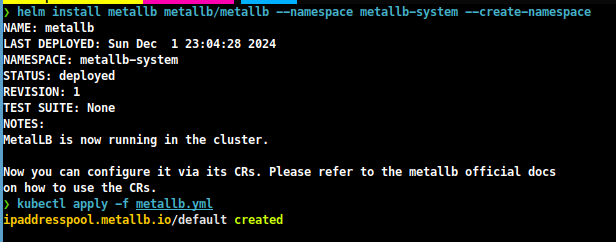
-
Verify the MetalLB installation by running the following command:
kubectl get pods -A # or use k9s cli k9s
Step 15: Install local-path-provisioner Storage Class
-
Finally, you can install the local-path-provisioner storage class on the Kubernetes cluster. The local-path-provisioner is a storage class that provides persistent storage for the containers running on the cluster. You can install the local-path-provisioner by running the following steps:
-
Install the local-path-provisioner with the following command:
# Install local-path-provisioner kubectl apply -f https://raw.githubusercontent.com/rancher/local-path-provisioner/v0.0.28/deploy/local-path-storage.yaml # Patch the local-path storage class kubectl patch storageclass local-path -p '{"metadata": {"annotations":{"storageclass.kubernetes.io/is-default-class":"true", "defaultVolumeType":"local"}}, "allowVolumeExpansion": true}'
-
Verify the local-path-provisioner installation by running the following command:
kubectl get pods -A # or use k9s k9s
Conclusion
- In this guide, I’ve shown you how to set up a K0s Kubernetes cluster using the Tailscale VPN infrastructure. Tailscale is a secure and easy to use VPN service that provides secure access to your network from anywhere in the world. K0s is a lightweight Kubernetes distribution that is designed for developers and small teams. By following the steps in this guide, you can set up a K0s Kubernetes cluster on your own machines and start deploying containerised applications.